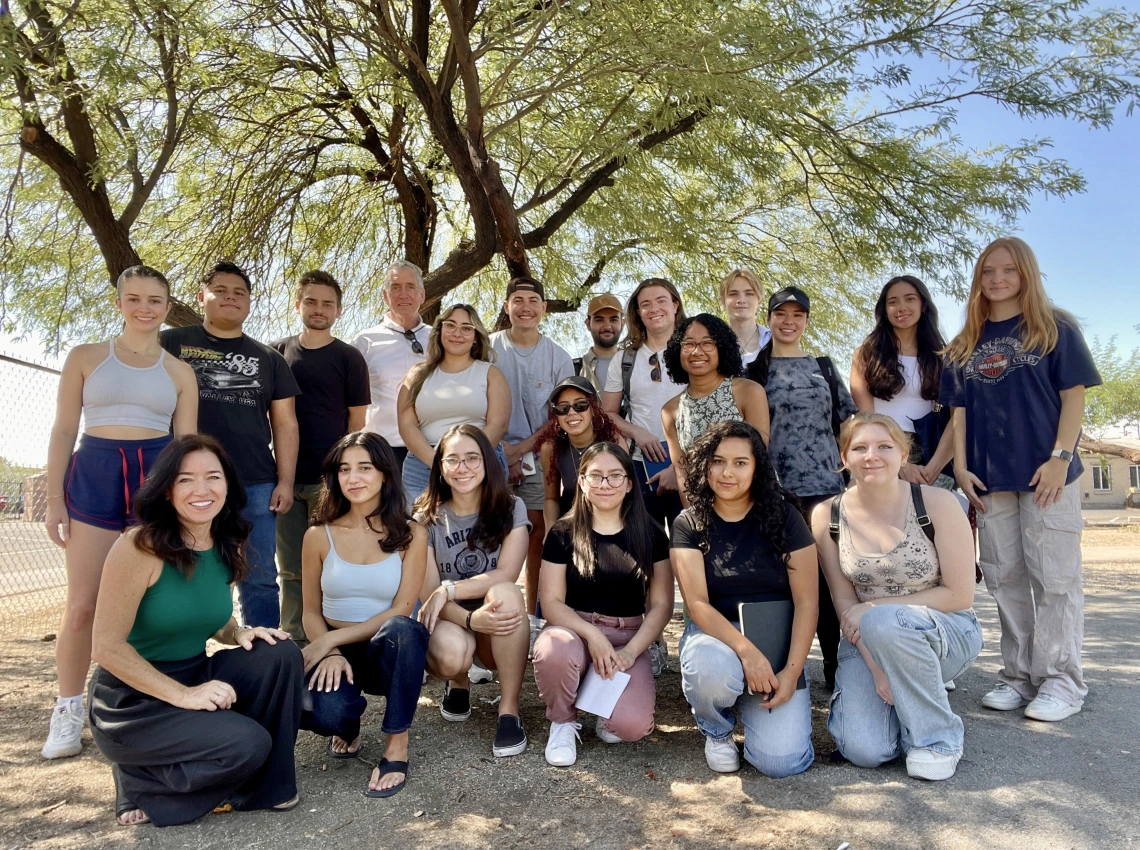CAPLA students partner with Tucson Hope Factory to address homelessness in Tucson

Led by CAPLA Assistant Professor of Practice Teresa Rosano, 17 fifth-year architecture students are working closely with the Drachman Institute, the City of Tucson, St. Francis Shelter Community, and the Tucson Hope Factory to develop micro shelters for Tucson's unhoused population.
A collaborative initiative between the College of Architecture, Planning and Landscape Architecture (CAPLA), the Drachman Institute, community organizations, and the City of Tucson is offering architecture students a unique opportunity to design and develop transitional housing solutions for Tucson’s unhoused population.
Led by CAPLA Assistant Professor of Practice Teresa Rosano, 17 fifth-year architecture students are taking part in this project as their capstone studio. In this effort, the students are working closely with the Drachman Institute, the City of Tucson, St. Francis Shelter Community, and the Tucson Hope Factory—the latter two organizations dedicated to addressing homelessness in Tucson.
Their work includes researching, designing, and prototyping micro-shelters, master planning for the Navajo Park site, and evaluating additional sites in Tucson, estimating costs, sourcing building materials, and investigating manufacturing and fabrication processes.
This collaboration began when the Tucson Hope Factory contacted the Drachman Institute about a potential project for an ideal micro shelter suited to Tucson’s climate, building codes, and regulations. After discussions with Chuck Dunn, executive director of the Tucson Hope Factory, the idea was integrated into the upcoming capstone course.
“I truly appreciate the collaboration with CAPLA, the Drachman Institute, and the students who have committed to developing innovative ideas for a mini shelter community that is affordable, sustainable, resilient, and can provide essential services like food and healthcare,” Dunn said.
Greg Veitch, research coordinator at the Drachman Institute, brings his expertise to the capstone course, having researched and presented on transitional micro shelter housing in previous Drachman Institute projects.
“It was an exciting idea, as the Drachman Institute was wrapping up a project with the City of Tucson on a larger analysis of transitional housing and potential code and regulatory changes,” said Courtney Crosson, director of the Drachman Institute. “Greg helped on the transitional housing analysis and will now support the construction component of the capstone work.”
When Souhayla Farag, a student in the course, first heard about the project, she was excited.
“The idea of creating a genuine impact and potentially making a real difference in the community was really compelling,” said Farag. “It felt like a meaningful way to wrap up my time at CAPLA.”
Rosano hopes that this project provides her students with firsthand experience before they graduate and begin their careers.
“This is an opportunity for students to practice communication and interaction with clients and stakeholders including non-profit representatives, users, governmental agencies and other community partners,” Rosano said. “The prototyping component provides a chance to learn about manufacturing through interaction with suppliers and an opportunity to apply their learnings from CAPLA Materials Lab and previous Design-Build experiences.”
Seattle and Portland are examples of U.S. cities that have implemented mini-home villages as innovative approaches to supporting unhoused populations. About half of the students will travel to Seattle to visit the Low Income Housing Institute and the Seattle Hope Factory, where they will see how these homes are manufactured and visit community shelter sites.
While Tucson faces challenges like those in Seattle and Portland, the solutions used in those cities are impractical for the extreme heat of the Sonoran Desert.
“The studio is charged with building on the learned success of these other example communities, but making it uniquely fit to Tucson for overall success,” said Crosson.
Through community engagement in Tucson, students are also gaining firsthand insight into the many facets of architecture projects that must be considered.
“The students have the unique opportunity to have an excellent final capstone project and a powerful impact on the Tucson community,” Crosson said. “I hope they learn not only about design, but about the many intersecting and important challenges on this project including cost and economy, innovative materials, code and regulatory constraints, health and wellbeing and fostering community.”
For the students, this project will be a memorable one.
“Some of my most rewarding experiences at CAPLA have come from engaging with the city and local communities,” said Farag. “This project is exciting because it offers the chance to do so while working closely with my classmates, creating something meaningful that I’ll be proud to look back on for the rest of my life.”



